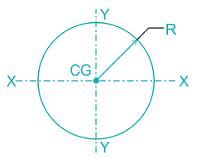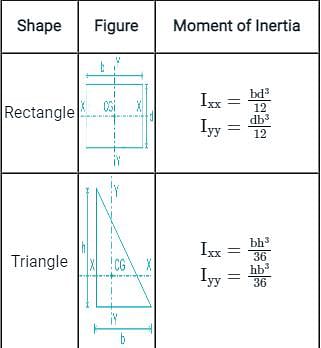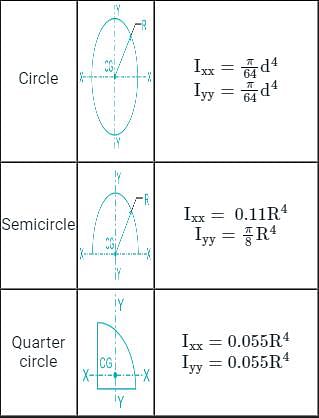Mechanical Engineering Exam > Mechanical Engineering Questions > The ratio of moment of inertia of a circular ...
Start Learning for Free
The ratio of moment of inertia of a circular plate to that of a square plate for equal depth is
- a)less than one
- b)equal to one
- c)greater than one
- d)none of the above
Correct answer is option 'A'. Can you explain this answer?
Most Upvoted Answer
The ratio of moment of inertia of a circular plate to that of a square...
Concept:
Moment of inertia of circular plate,


Moment of inertia of Square plate,


Calculation:
The ratio of the moment of inertia of a circular plate to that of a square plate is, Which is less than 1.
Important Points
The following table shows the Second moment of inertia of different shapes


Moment of inertia of circular plate,


Moment of inertia of Square plate,


Calculation:
The ratio of the moment of inertia of a circular plate to that of a square plate is, Which is less than 1.
Important Points
The following table shows the Second moment of inertia of different shapes


Free Test
FREE
| Start Free Test |
Community Answer
The ratio of moment of inertia of a circular plate to that of a square...
The moment of inertia is a property of an object that measures its resistance to rotational motion. It depends on the mass distribution of the object and the axis of rotation. For a circular plate and a square plate of equal depth, the mass is distributed differently, leading to different moment of inertia values.
The moment of inertia of a circular plate is given by the formula:
I_circular = (1/4) * m * r^2
where m is the mass of the plate and r is the radius of the plate.
The moment of inertia of a square plate is given by the formula:
I_square = (1/12) * m * h^2
where m is the mass of the plate and h is the side length of the square plate.
To compare the two moment of inertia values, we can take the ratio of I_circular to I_square:
I_circular / I_square = [(1/4) * m * r^2] / [(1/12) * m * h^2]
The mass cancels out in the ratio, so we are left with:
I_circular / I_square = (r^2) / (3 * h^2)
From the equation, we can see that the ratio of the moment of inertia of a circular plate to that of a square plate depends on the ratio of r^2 to h^2.
Now, let's consider a circular plate and a square plate with equal depth. This means that the height of the square plate is equal to the diameter of the circular plate (h = 2r). Substituting this into the ratio equation:
I_circular / I_square = (r^2) / (3 * (2r)^2) = (r^2) / (12r^2) = 1/12
So, the ratio of moment of inertia of a circular plate to that of a square plate for equal depth is 1/12, which is less than one. Therefore, the correct answer is option A: less than one.
The moment of inertia of a circular plate is given by the formula:
I_circular = (1/4) * m * r^2
where m is the mass of the plate and r is the radius of the plate.
The moment of inertia of a square plate is given by the formula:
I_square = (1/12) * m * h^2
where m is the mass of the plate and h is the side length of the square plate.
To compare the two moment of inertia values, we can take the ratio of I_circular to I_square:
I_circular / I_square = [(1/4) * m * r^2] / [(1/12) * m * h^2]
The mass cancels out in the ratio, so we are left with:
I_circular / I_square = (r^2) / (3 * h^2)
From the equation, we can see that the ratio of the moment of inertia of a circular plate to that of a square plate depends on the ratio of r^2 to h^2.
Now, let's consider a circular plate and a square plate with equal depth. This means that the height of the square plate is equal to the diameter of the circular plate (h = 2r). Substituting this into the ratio equation:
I_circular / I_square = (r^2) / (3 * (2r)^2) = (r^2) / (12r^2) = 1/12
So, the ratio of moment of inertia of a circular plate to that of a square plate for equal depth is 1/12, which is less than one. Therefore, the correct answer is option A: less than one.

|
Explore Courses for Mechanical Engineering exam
|

|
Similar Mechanical Engineering Doubts
The ratio of moment of inertia of a circular plate to that of a square plate for equal depth isa)less than oneb)equal to onec)greater than oned)none of the aboveCorrect answer is option 'A'. Can you explain this answer?
Question Description
The ratio of moment of inertia of a circular plate to that of a square plate for equal depth isa)less than oneb)equal to onec)greater than oned)none of the aboveCorrect answer is option 'A'. Can you explain this answer? for Mechanical Engineering 2025 is part of Mechanical Engineering preparation. The Question and answers have been prepared according to the Mechanical Engineering exam syllabus. Information about The ratio of moment of inertia of a circular plate to that of a square plate for equal depth isa)less than oneb)equal to onec)greater than oned)none of the aboveCorrect answer is option 'A'. Can you explain this answer? covers all topics & solutions for Mechanical Engineering 2025 Exam. Find important definitions, questions, meanings, examples, exercises and tests below for The ratio of moment of inertia of a circular plate to that of a square plate for equal depth isa)less than oneb)equal to onec)greater than oned)none of the aboveCorrect answer is option 'A'. Can you explain this answer?.
The ratio of moment of inertia of a circular plate to that of a square plate for equal depth isa)less than oneb)equal to onec)greater than oned)none of the aboveCorrect answer is option 'A'. Can you explain this answer? for Mechanical Engineering 2025 is part of Mechanical Engineering preparation. The Question and answers have been prepared according to the Mechanical Engineering exam syllabus. Information about The ratio of moment of inertia of a circular plate to that of a square plate for equal depth isa)less than oneb)equal to onec)greater than oned)none of the aboveCorrect answer is option 'A'. Can you explain this answer? covers all topics & solutions for Mechanical Engineering 2025 Exam. Find important definitions, questions, meanings, examples, exercises and tests below for The ratio of moment of inertia of a circular plate to that of a square plate for equal depth isa)less than oneb)equal to onec)greater than oned)none of the aboveCorrect answer is option 'A'. Can you explain this answer?.
Solutions for The ratio of moment of inertia of a circular plate to that of a square plate for equal depth isa)less than oneb)equal to onec)greater than oned)none of the aboveCorrect answer is option 'A'. Can you explain this answer? in English & in Hindi are available as part of our courses for Mechanical Engineering.
Download more important topics, notes, lectures and mock test series for Mechanical Engineering Exam by signing up for free.
Here you can find the meaning of The ratio of moment of inertia of a circular plate to that of a square plate for equal depth isa)less than oneb)equal to onec)greater than oned)none of the aboveCorrect answer is option 'A'. Can you explain this answer? defined & explained in the simplest way possible. Besides giving the explanation of
The ratio of moment of inertia of a circular plate to that of a square plate for equal depth isa)less than oneb)equal to onec)greater than oned)none of the aboveCorrect answer is option 'A'. Can you explain this answer?, a detailed solution for The ratio of moment of inertia of a circular plate to that of a square plate for equal depth isa)less than oneb)equal to onec)greater than oned)none of the aboveCorrect answer is option 'A'. Can you explain this answer? has been provided alongside types of The ratio of moment of inertia of a circular plate to that of a square plate for equal depth isa)less than oneb)equal to onec)greater than oned)none of the aboveCorrect answer is option 'A'. Can you explain this answer? theory, EduRev gives you an
ample number of questions to practice The ratio of moment of inertia of a circular plate to that of a square plate for equal depth isa)less than oneb)equal to onec)greater than oned)none of the aboveCorrect answer is option 'A'. Can you explain this answer? tests, examples and also practice Mechanical Engineering tests.

|
Explore Courses for Mechanical Engineering exam
|

|
Signup for Free!
Signup to see your scores go up within 7 days! Learn & Practice with 1000+ FREE Notes, Videos & Tests.


























